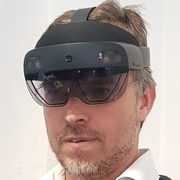Xtended or Mixed Reality (AR+VR) for Education 2024
A special issue of Computers (ISSN 2073-431X).
Deadline for manuscript submissions: closed (1 August 2024) | Viewed by 6120
Special Issue Editors
Interests: human-robot interaction; humanoid robot; man-machine systems; augmented reality; education; online learning; moodle; learning management system; dashboards
Interests: mixed reality; industrial applications; technical training; user studies
Special Issues, Collections and Topics in MDPI journals
Special Issue Information
Dear Colleagues,
Educational technologies have shown great impact on learning effectiveness, engagement, and motivation. Experts claim that recent advances in MR, and thus virtual and augmented reality, are candidates for becoming the next generation of educational tools. The advantages are manifold: AR technology makes the acquisition of knowledge and skills and the related visualization at the right place (registration of multimedia content) and time (understanding the specific user needs) possible in real time.
VR at different levels of immersion can provide very flexible educational payload anytime and anywhere, and thus education and learning materials become more accessible. While the gaming industry is providing low-cost and effective devices with quick turnarounds, there are many issues still to be solved. The scientific literature is still not mature and lacks user studies and guidelines in different fields (such as surgery, plane flying, etc.), user age information, and background information.
In this Special Issue, we would like to present methods, experiences, case studies, and experiments which could potentially lead to significant advances in MR reality for learning.
The main topics include but are not limited to:
- MR for schools, education, and children;
- MR for impaired, disabilities, rehab;
- MR virtualization of learning—principles, technologies, tools;
- Design and implementation of augmented reality learning environments;
- MR educational guidelines and user studies;
- Aspects of environmental and augmented reality security and ethics;
- Science education methods;
- MR industrial professional training;
- MR social and technical issues;
- Augmented healthcare, quality of life, and well-being;
- Augmented reality for sports training;
- Augmented reality and serious games;
- Rehabilitation and assistive augmentation;
- Augmented intelligence.
Dr. Veronica Rossano
Dr. Michele Fiorentino
Guest Editors
Manuscript Submission Information
Manuscripts should be submitted online at www.mdpi.com by registering and logging in to this website. Once you are registered, click here to go to the submission form. Manuscripts can be submitted until the deadline. All submissions that pass pre-check are peer-reviewed. Accepted papers will be published continuously in the journal (as soon as accepted) and will be listed together on the special issue website. Research articles, review articles as well as short communications are invited. For planned papers, a title and short abstract (about 100 words) can be sent to the Editorial Office for announcement on this website.
Submitted manuscripts should not have been published previously, nor be under consideration for publication elsewhere (except conference proceedings papers). All manuscripts are thoroughly refereed through a single-blind peer-review process. A guide for authors and other relevant information for submission of manuscripts is available on the Instructions for Authors page. Computers is an international peer-reviewed open access monthly journal published by MDPI.
Please visit the Instructions for Authors page before submitting a manuscript. The Article Processing Charge (APC) for publication in this open access journal is 1800 CHF (Swiss Francs). Submitted papers should be well formatted and use good English. Authors may use MDPI's English editing service prior to publication or during author revisions.
Keywords
- augmented reality
- virtual reality
- mixed reality
- educational technology
- serious games
- sports training
- industrial training
- rehabilitation
Benefits of Publishing in a Special Issue
- Ease of navigation: Grouping papers by topic helps scholars navigate broad scope journals more efficiently.
- Greater discoverability: Special Issues support the reach and impact of scientific research. Articles in Special Issues are more discoverable and cited more frequently.
- Expansion of research network: Special Issues facilitate connections among authors, fostering scientific collaborations.
- External promotion: Articles in Special Issues are often promoted through the journal's social media, increasing their visibility.
- e-Book format: Special Issues with more than 10 articles can be published as dedicated e-books, ensuring wide and rapid dissemination.
Further information on MDPI's Special Issue polices can be found here.






